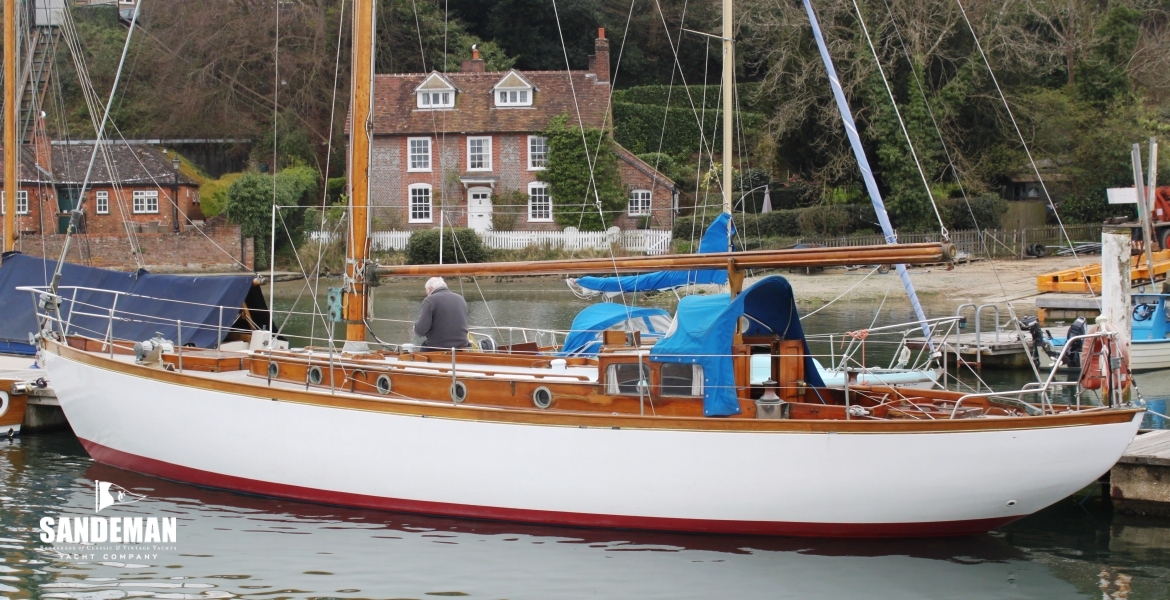


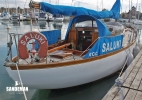
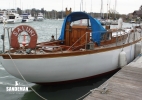
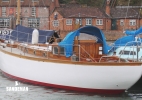
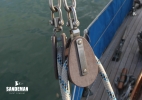
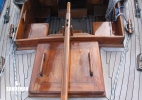
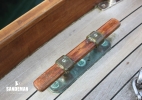
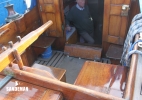
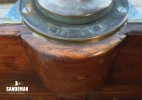
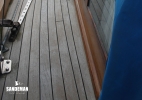
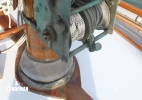
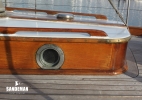
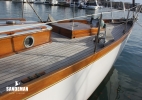
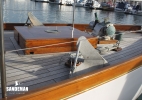
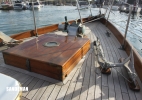
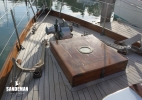
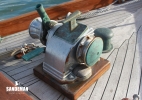
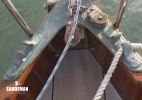
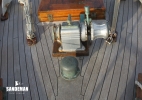
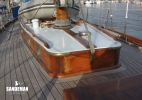
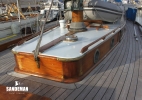
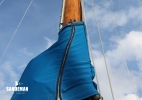
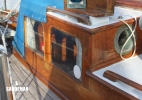
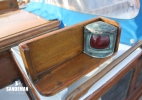

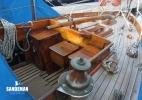
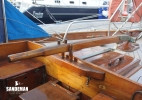
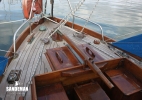
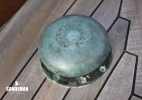
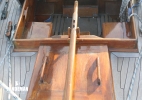
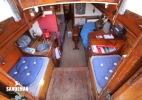
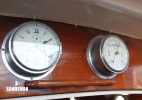
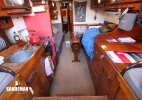
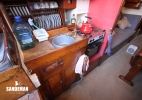
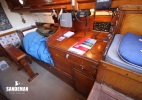
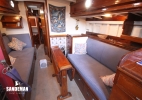
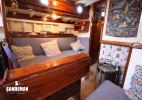
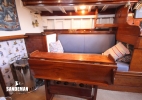

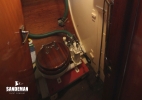


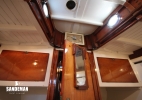

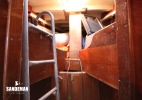
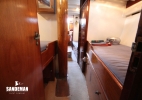
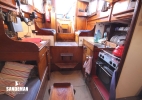
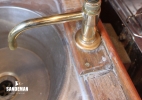
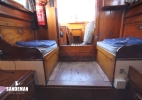
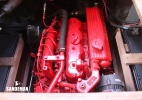
![53 Hauled-out [by David Russell]](https://images.sandemanyachtcompany.co.uk/uploads/boats/142x100_457_14533995475c86826dd3da9.JPG)
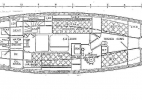
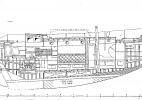

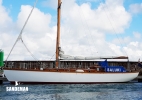
| Designer | H G May |
|---|---|
| Builder | Berthon Boat Co Ltd |
| Date | 1946 |
| Length overall | 41 ft 0 in / 12.5 m |
| Length deck | 41 ft 0 in / 12.5 m |
| Length waterline | 32 ft 10 in / 10 m |
|---|---|
| Beam | 9 ft 8 in / 2.95 m |
| Draft | 5 ft 11 in / 1.8 m |
| Displacement | 12.2 Tonnes |
| Construction | Mahogany planking on oak frames |
| Engine | Beta Marine 4 cyl Diesel |
|---|---|
| Location | United Kingdom |
| Price | GBP 49,995 |
These details are provisional and may be amended
The Yachting World supplement of 1951 wrote that the 12 ton Gauntlet was one of the first boats to be built to the RORC rating – exactly what the originators of the Rule had in mind; fast and immensely seaworthy.
SALUKI has now been in the same ownership for over 40 years – and in that time looked after by the Elephant Boatyard. She remains in impressive and original condition – exhibiting a charming patina that is virtually impossible to replicate in a recently restored boat.
Interested in SALUKI in more detail.
The distinctive “Gauntlet” name merits mention of how it came to be. In short; HG May was approached by a potential client to design a boat suitable for cruising and offshore racing. On seeing the finished design plans for a 12 ton boat, the client apparently had second thoughts about accepting it and approached another designer for an alternative based on the same requirements – and in accepting it, rejected May’s design. May having invested time and effort was understandably annoyed but with faith in it; had the yard build him a boat to this his own design – and threw down the gauntlet in challenging his erstwhile client to a match race; one new boat against another. May’s confidence was fully vindicated by winning this contest comfortably and setting up the successful Gauntlet class against the current design concepts of his competitors.
Launched in 1934, GAUNTLET was the first of the 12 tonners, after which the type has always been known. When she was designed very few, if any yachts had been specially built to the RORC rating and it was thought that it was this very type of yacht which the originators of the RORC rule had in mind when they produced it. In other words a comfortable cruising yacht with a fair turn of speed - although since then, a very different type of yacht has evolved. The 12-ton "Gauntlets" soon established themselves and sixteen were built in the five years before the 2nd World War, many of which have given a very good account of themselves in offshore racing; notably BRAMBLING AND GREENGAGE, to mention only two.
In due course it was natural enough that some owners of these yachts would plump for a larger vessel and consequently some 14, 18 and even 25-tonners were built of the same type. The first of the 14-tonners; LOLLYPOPPETT, was built in 1939. This design was based essentially on the original 12 but she was given a waterline length of 32 ft 6 ins and a beam of 9 ft 7 ½ in. The displacement is fairly high, though less proportionately than 12-tonners. The aim was to produce a thoroughly comfortable and seaworthy cruising yacht, with rather more room than the original 12, in which the owner could take part in offshore races. The 14 Tonners went very well and in addition to SALUKI eight others were built after the War
Even before 1939 the "Gauntlets" had been noticed as hard-weather boats but equally they have proved remarkably successful under a variety of conditions and many people have wondered why. Some designers are lucky in getting good owners and "Gauntlets" have generally been fortunate in this respect; for a yachtsman who buys a vessel of this kind usually intends to go in for serious cruising with an eye to offshore and passage racing as well. SALUKI the first 14-ton "Gauntlet” to be launched after World War II was built for Major W M Martineau MC vice- commodore of the Royal Lymington YC. Her second owner was Roger Leigh-Wood.
The most striking feature of SALUKI’s lines is the fact that with only a little over 5 ft 10 in draft, the 14-ton "Gauntlet” has a good deal less than the maximum then allowed by the RORC Rule, which, at 16 per cent of the LWL plus 2 ft, works out about 7ft 3 in. The next outstanding characteristic is the narrow beam of only 9 ft 6 in on a water line length of 33ft. The sections reveal easy garboards and bilges with a deep hull which allows a low cabin sole with plenty of headroom. The hull has been given little bow overhang and the profile runs in a sweet continuous curve from the stem head to the heel, A short canoe stem matches the bow, which, unlike many yachts to-day, is free from snubbing.
A deep narrow boat with short ends is economical to build as the minimum quantity of timber is needed so construction can thus err on the generous side without adding unduly to the weight of the hull. The added strength in its turn makes for confidence at sea and durability leading to low maintenance costs. The displacement of 12.2 tons is high – embracing a heavy keel and with 5 ½ tons of lead, Saluki's ballast ratio is slightly over 45 per cent. The secret of the "Gauntlet's" success probably lies in this heavy keel, which confers the stability which would otherwise be lacking in the narrow, easy sectioned, rather light drafted hull. Yachts of this type quickly take up an initial angle of heel and, as the weight of the keel comes into play, become increasingly stiff.
The narrow beam helps to make a fast boat to windward but the steep buttocks, which cannot be avoided because of the depth of the hull amidships, tend to limit maximum speed, although the hull, on account of its other characteristics, would be very easily driven at medium speeds, Sail area can thus be kept on the moderate side. It is these factors which tend to make the" Gauntlets" perform well in most conditions and on most points of sailing, and so maintain a high average speed. The straight sheer combined with high freeboard gives the "Gauntlet" a slightly “boxy" look which takes a little getting used to. The above average freeboard might be a disadvantage in a vessel with long ends and a cocked up bow on account of the extra weight and windage where it is least wanted but the "Gauntlet," with her short overhangs, does not suffer in this respect.
- African mahogany planking on English oak frames
- English elm keel
- Oak timbers
- Oak shelf stringers and clamp
- Galvanised steel floors and hanging knees
- Teak deck ¾ inch planking over ply sub deck new 2007
- Teak toe rail new
- Teak and mahogany superstructure
From aft
- Canoe stern
- Varnished teak toe rail
- Bronze fairleads each side on bronze stern fitting over taff rail
- Stainless steel semi pushpit
- Chromed stanchions and wire guard rails leading fwd each side
- Bronze mushroom vent
- Teak and bronze mooring cleats each side
- All Tufnol main sheet blocks
- Bronze and teak tiller
- Stainless steel sheaves outboard for wire running backstays
- Laurent Giles running backstays levers with wooden handles
- Raised varnished hatch to lazarette – fisherman’s anchor stowed therein
- Coamings to deep cockpit
- 3 x Teak hatches over; diesel tank to port, centre steering compass, engine controls 2 speed stbd
- Lifting hatch in cockpit sole accesses shaft and aft section of engine
- Bronze Merriman Genoa sheet winches on pedestals outboard each side
- Seats in fwd corner each side
- Stainless steel Genoa tracks transverse on each side deck
- Tufnol foresail cars
- Raised Doghouse aft section with large side windows and bronze port lights fwd
- Sliding hatch under blue canvas spray hood
- Navigation side lights in teak screens each side fwd
- Long lower trunk cabin with port lights each side
- Varnished handrails on doghouse and lower coach roof each side
- Stowage for Avon dinghy under boom
- Chocks for life raft
- Mast
- Jib pole stowed port side deck
- Mushroom vent
- Raised varnished fore hatch
- CQR 45 lb anchor stowed on teak chocks to port
- CQR 35 lb anchor stowed on teak chocks to stbd
- 60 fathoms 7/16th galvanised chain
- Manual windlass with gypsy and warping drum
- Bronze raised mushroom vent
- Teak and bronze mooring cleats each side
- Bronze fairleads on bronze stem head fitting
- Bow roller each side
- North Sails furler
- Stainless steel pulpit
- Summary sleeps 4 in two main cabins and 2 in the foc’sle
- Sliding hatch in doghouse
- 2 x Seats; one each side with stowage lockers outboard
- Battery lockers under seats
- Sestrel chromed clock and barometer on fwd bulkhead over
- 3 x Companionway steps down
Galley to port
- Stainless steel sink with brass manual tap
- Nelson 2 burner hob and oven
- Waeco fridge / freezer
- Plate racks and utensil lockers 2013
- Crockery; plates and cups etc
- Opening port
Nav station to stbd
- Full size chart table
- Nav instruments
- Electrics isolator panel
Saloon fwd
- 4 x opening ports
- 2 x Settee berths; one each side with lee cloths
- Lockers under and outboard
- Stbd berth has trotter box aft under chart table
- Gimballed drop leaf table off centreline
- Refleks type 61 M oil cabin heater
- Drinks cabinet stbd
- 2 x Oil lamps
- Doorway access fwd by mast
- Very deep hanging locker to port
Head compartment fwd to stbd
- Baby Blake manual WC serviced annually
- Opening port
- Deck head light
Fore cabin
- Single berth to port
- Larger single berth to stbd
- Stowage lockers under berths
- Lockers fwd above each side and locker above stbd aft
- 4 x Opening ports
- 2 x Deck head lights
- Doorway fwd
Focsle
- 2 x Raised berths; one each side
- Hatch in foredeck over
- Galvanised demountable ladder
- Fridge box
- Anchor chain locker under berth
- Original spruce spars including spinnaker pole
- Additional Duralumin spinnaker pole
- Nearly new standing rigging
- Ibbotson Moore main, jib and topping lift halyard winches
- Hood foresail furler
- Main sail; Richardson 2011 in GC
- Genoa; Richardson 2011 in GC
- Gennaker
- 2 x jibs
- Trysail; Banks, old but unused
- Sun cover for deck
- Main sail cover
- Winter covers and steel supports
- Blue spray hood
- Beta Marine BV 1903 43 BHP 4 cyl Diesel engine 1998 – stripped and repainted 2008
- Fixed 3 bladed propeller new 2014
- Alternator
- 2 x Domestic sealed 150 Ah 12 V batteries
- Engine start sealed 15 Ah 12 V battery
- DC Matrix meter for each battery
- Control panel at Chart table
- Shore power 240
- Deck lights on mast spreaders
- 1 x 35 gallon / c 160 litre diesel tank
- 2 x 40 gallon / 182 litre fresh water tanks in bilge
- Manual water pump at galley sink
- Garmin Map 750 chart plotter – by companionway stbd under spray hood
- Garmin GPS
- B&G Network Quad
- Raymarine radar
- Marine VHF radio
- Garmin 1/6 M411 transceiver
- Plastimo steering compass
- Autohelm ST4000
- Hydrovane self steering
- 4 x Life jackets
- Avon Dinghy 260 May 2006 Yamaha 2.5 outboard
- Auto electric bilge pump
- Manual bilge pump
- Foam fire extinguishers
- Fire blanket
- Varnished wooden swimming ladder
Contact us to discuss SALUKI in more detail.
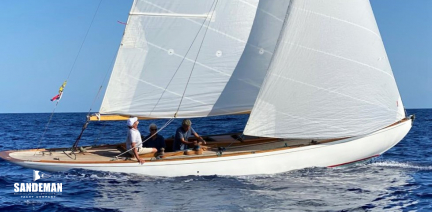
| Name | NATICA |
|---|---|
| Designer | H G May |
| Builder | Berthon Boat Co Ltd |
| Date | 1928 |
| Length deck | 34 ft 5 in / 10.5 m |
| Beam | 7 ft 7 in / 2.3 m |
| Draft | 5 ft 4 in / 1.62 m |
| Displacement | 4.8 Tons |
| Location | France |
| Price | EUR 85,000 |
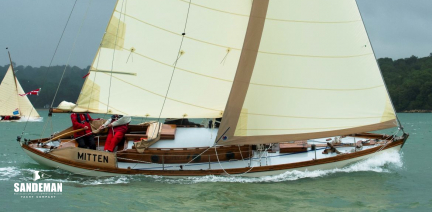
| Name | MITTEN |
|---|---|
| Designer | Rodney W. Paul & H.G. May |
| Builder | Berthon Boat Co Ltd |
| Date | 1937 |
| Length deck | 32 ft 0 in / 9.75 m |
| Beam | 8 ft 5 in / 2.56 m |
| Draft | 5 ft 6 in / 1.68 m |
| Displacement | 8 Tons |
| Location | Italy |
| Price | GBP 75,000 |
These particulars have been prepared from information provided by the vendors and are intended as a general guide. The purchaser should confirm details of concern to them by survey or engineers inspection. The purchaser should also ensure that the purchase contract properly reflects their concerns and specifies details on which they wish to rely.